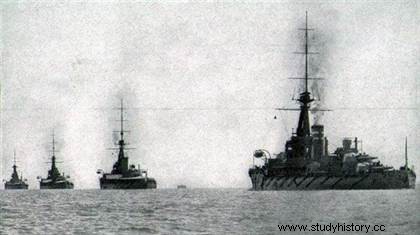 The Battle of Jutland was the greatest naval battle of the First World War, fought between the British and German fleets on May 31 and June 1, 1916. As the war on land got bogged down in the trenches and then the hell of Verdun , the clash has not yet taken place at sea between the two European rivals, the British Empire and the German Empire. It was at the end of May 1916, off Denmark, that their fleets finally clashed.
The Battle of Jutland was the greatest naval battle of the First World War, fought between the British and German fleets on May 31 and June 1, 1916. As the war on land got bogged down in the trenches and then the hell of Verdun , the clash has not yet taken place at sea between the two European rivals, the British Empire and the German Empire. It was at the end of May 1916, off Denmark, that their fleets finally clashed.
German and British strategies
The beginning of the 20th century saw the German Empire become a serious competitor to British power. This is particularly the case in the field of the navy, with the decisive influence of Grand Admiral Alfred Von Tirpitz (1849-1930) who will move the Hochseeflotte from sixth to second place among naval powers, just behind England, by a series of laws between 1898 and 1908. However, Kaiser Wilhelm II denied him the right to confront the British fleet when the war had started…
Two strategies confronted each other at the start of the conflict:the British believed in the war of attrition (thanks to their mastery of the seas and strategic straits), the Germans in war -eclair (especially since they had long hoped for neutrality on the part of the English); strategies which obviously have their influence on the maritime domain.
On the German side, there is quickly a dilemma:should we use the remarkable weapon of Tirpitz, or keep it as a threat for possible negotiations? The first option is risky because, despite the progress of the German fleet, the Allies have de facto mastery of the seas and it would take a significant effort (and the risks that go with it) to challenge them. The strategy chosen is therefore defensive, to the great displeasure of Admiral Tirpitz:the fleet must protect the coasts, support the land offensive and all the same begin to wear down the enemy navy, dividing it with targeted attacks. It's a racing war, even if it doesn't go as far as the one launched in 1939...
On the British side, the Grand Fleet is vital to the very survival of England! Its role is above all to maintain communications between Great Britain, its Empire and the rest of the world. This control of communications also serves to isolate the German enemy, through the blockade. But the growing underwater threat and the underestimated system of mines (the area of Jutland is very suitable for this) undermine this strategy. This forces the Admiralty to keep its ships in port and watch for any enemy exits to counterattack. This is exactly what will happen, off the Jutland peninsula.
The forces present in Jutland
As we have seen, Tirpitz's policy greatly improved the German navy, making it the first rival of the British fleet. However, it still has a good head start, especially in quantitative terms:Admiral Jellicoe's Grand Fleet has twenty-nine dreadnoughts (including the flagship Iron Duke ), five battlecruisers, eight battlecruisers, fourteen light cruisers and dozens of destroyers, all organized into five "battle" squadrons and a lighting force of three squadrons (plus the torpedo boat flotillas). To this must be added the Channel Fleet, which acts in coordination with the French Navy, and which is made up of old battleships and destroyers, even if it is far from Jutland, the scene of the coming battle. 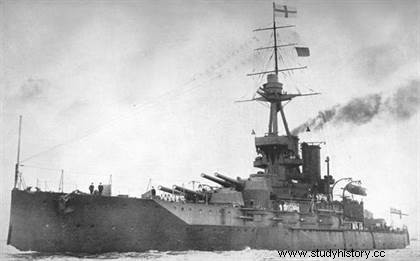
While the number is therefore largely in favor of the British, especially on heavy ships, the quality is different. It is first of all the artillery, where the Germans are clearly superior, whether in terms of precision, reliability, speed of fire or quality of shells! In addition, torpedoes and submarines, but also mines, are of higher quality on the German side.
We can therefore say that the confrontation that is looming is far from a foregone conclusion...
The beginnings of the Naval Battle of Jutland appear from the beginning of 1916, first with changes in the command of the Hochseeflotte, then by the first German attacks aimed at preparing the naval offensive which will have to be rapid and decisive. But the British secret services are watching...
Von Scheer and the Zeppelins
The first important moment in the coming battle was the appointment as head of the Hochseeflotte of Vice-Admiral Reinhard von Scheer in January 1916. Unlike Pohl, his predecessor, Scheer favors a more offensive strategy. His British counterpart, John Jellicoe, is more cautious as the navy is crucial for the survival of England, and he sees a massive clash between the two fleets as only "the ultimate solution".
Scheer intends to take advantage of what he sees as the enemy's reluctance:without committing the bulk of his fleet, he gets to be able to exert more pressure aggressive action against Great Britain, by the action of submarines against communications, by sorties from her ships to lure a divided British fleet into her waters, and finally by a bombardment on English soil in retaliation for the blockade. This is where the Zeppelins come into action which, from January 1916, bombard Liverpool indiscriminately! Airships also used as reconnaissance craft to avoid being surprised by the Grand Fleet.
During the following weeks, Scheer launched other offensives to test the enemy defenses, mainly with torpedo boats. This begins to annoy the British as the pursuit fails on their nightmare, the dreaded German minefields! British opinion protested that its fleet was unable to protect its coasts, and a degree was crossed when Scheer, covered by the bombardment of Zeppelins on the South and East of England, managed to bring about twenty line vessels off Zeebrugge; but fortunately for England he does not dare to go as far as Pas-de-Calais… Raids are organized to destroy the airship factories, without success. Vice-Admiral Beatty, known for his spirit of initiative, tries with his battlecruisers to counter-attack in turn; Scheer then saw the opportunity to trap him and deal a major blow to the English fleet, but bad weather dissuaded him from pushing his effort further, despite a few skirmishes.
This is taken who thought he was taking?
April saw increased German air attacks, much to the chagrin of civilian populations. Scheer actually intends to push Beatty to the fault, bring him out and attack him outnumbered with the Hochseeflotte and the help of the submarines. At the end of April, the German vice-admiral brings out his entire fleet but the British secret services, which have deciphered the enemy messages, allow the Grand Fleet not to be surprised; she sets sail for Heligoland. But, once again, Scheer's mist and caution postpone the big fight after some fire is exchanged between the cruisers.
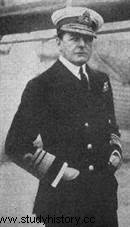
It is only a postponement as the pressure weighs on the two commanders:the English population is exasperated that its fleet cannot protect it from raids, and on the German side the abandonment of all-out submarine warfare (under American threat) puts all hopes on decisive action by the Hochseeflotte. Jellicoe, despite his (too?) cautious character, must resolve to a confrontation, which Scheer hopes for but obviously having the initiative.
On May 30, British intelligence informs the Admiralty that the enemy fleet is regrouping, and the order is given to weigh anchor. For his part, Scheer is completely unaware that the English are aware of his movements, and that he will fall into the trap he intended to set! Scheer's "carrot" is Rear Admiral Hipper's squadron, which must remain in North Jutland, the aim being once again to attract Beatty , British vanguard and isolated from the Grand Fleet.
Despite the intelligence, the British made several mistakes, and the fate seemed to be turning in favor of Scheer:first the trap against Beatty worked, because Beatty didn't wait the Grand Fleet to rush towards Hipper which sails towards Jutland; indeed, the Admiralty does not know that Scheer, if he sailed, was also not far south of Hipper's position. Then, a confusion of transmissions led Jellicoe to deprive himself of his seaplane transport, which was to provide lighting for his fleet. Fortunately for the English, Scheer must in turn deprive himself of aerial reconnaissance, but also submarines, unable to damage the enemy fleet and above all to warn of his exit from the harbours!
The first shots and the first victim
Beatty arrives at his rendezvous point near Jutland, and positions himself to "receive" Hipper's squadron. He is sure of his strength, he has indeed six battlecruisers and four dreadnoughts, while opposite Hipper should only field five battlecruisers. But then comes a coincidence that makes these battles so legendary:a Danish freighter passing by is simultaneously spotted by the two squadrons who then send a vanguard for confirmation; Of course, they spot each other! The fight begins, and it's the British cruiser Galatea who took the first shell of the Battle of Jutland.
The British squadron is surprised and Beatty, who was already not well placed at the start, is forced to detach his battlecruisers from his dreadnoughts to retaliate in better conditions . The confusion is once again great on both sides, and the fleets still end up meeting for the confrontation; but Hipper managed to steer Beatty south so they were both heading straight for the Hochseeflotte! Meanwhile, the Grand Fleet picks up the pace to come to the aid of its vice-admiral…
The two squadrons advance in parallel lines, separated by 18,000 meters, the Lion by Beatty and the Lützow of Hipper at the top of each. The German cruiser opened fire first, followed by the British lead ships. Beatty has the numerical advantage, but the German orders are more accurate, as are the shots:the English flagship and the Princess Royal are hit twice, the Tiger four times ! It's the latter and the Lion who suffer the most serious damage. Fortunately, the Queen Mary manages to hit the Seydlitz and weaken his shot, then the Lützow is hit in turn. It is 4 p.m., the fight has not started for a quarter of an hour since the Lion is once again beaten very violently, and almost put out of action! But it's the cruiser Indefatigable , knocked out by the Von Der Tann, who is the first victim of the Battle of Jutland:he capsizes with almost 1000 men (there will only be two survivors rescued)!
The arrival of British dreadnoughts off Jutland
The melee continues, increasingly confused, especially with the decision of the German cruiser Moltke to launch torpedoes. Rear Admiral Hipper then tries to increase his initiative by getting closer to the enemy, but he finds himself under threat from the armored squadron (the dreadnoughts) that Beatty had had to leave behind him and which finally joins him! This squadron is made up of the most recent heavy ships of the English navy, and it is therefore a reinforcement of weight for Beatty, sounded by the attack of Hipper:the Barham opens fire on the Von Der Tann, followed by the Valiant , the Warspite and Malaya which also target the Moltke. This gives Beatty a break, and Hipper can't deliver the final blow:the intensity of the fight then drops...
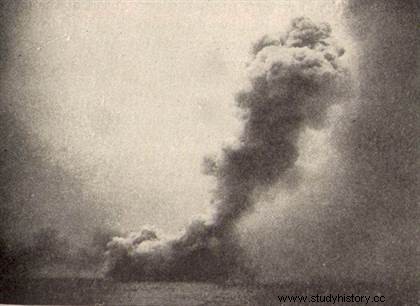
The fight however resumes more violently as Hipper has managed to close in again:the Lion is hard hit, just like on the German side the Von Der Tann and the Seydlitz. However, the latter, aided by the Derfflinger , focuses his shot on the Queen Mary; that explodes at 4:26 p.m.! If most of the German buildings have suffered damage, the British are already deploring the loss of two cruisers… But Beatty still refuses to withdraw.
The Hochseeflotte is in sight
It is then up to the light ships, the torpedo boats, to enter the dance. Then begins a furious ballet between these fast and agile ships which exchange blow for blow. The British take the advantage, hitting the German cruisers, forcing them to divert fire from their English rivals. It was time, because Scheer's Hochseeflotte is already in sight! It is barely 5 p.m., the English have lost two cruisers and two destroyers, the Germans two of these light ships as well, but none heavy; nevertheless, several of their cruisers saw their firepower diminished by the blows struck, and without Scheer's arrival Hipper's squadron was at great risk. The Battle of Jutland is not over.
The appearance of the Hochseeflotte obviously does not reassure Beatty, who then tries to train Scheer and Hipper north of the Jutland region, straight on the Grand Fleet. Indeed, the Germans still do not know that Jellicoe's fleet has sailed. But transmission errors still occur, and the English fleet finds itself partly disorganized and divided:the armored squadron (that of Barham ) must engage the Hochseeflotte, as Beatty attempts to join the Grand Fleet. The Warspite is hard hit, but it is mostly the Malaya who takes the blows of the König . Fortunately, the damage is not decisive and the balance sheet finally not heavy, to the great displeasure of the Germans. Beatty can then breathe a little. It's 5:15 p.m.
The shooting resumes less than a quarter of an hour later, between on one side the Lion (badly damaged), the Princess Royal , the Tiger , the New Zealand , and on the other the Lützow , the Seydlitz and the Derfflinger . The German flagship is badly hit, and Hipper must withdraw! The squadron of Rear Admiral Hood arrives at the same time, forcing the German commander to try to join the Hochseeflotte. Beatty receives support from the cruisers Chester and Canterbury; but the first is a little too reckless and, assailed by German fire, he owes his salvation only with the help of The Invincible . The Grand Fleet is meanwhile deploying in a bit of confusion, as the Germans understand its arrival too late.
Then comes the Defence , an old English cruiser who wants to join in the battle, even though she is not level with the enemy buildings; accompanied by the Warrior , he adds to the confusion by wanting to complete the Wiesbaden ! Caught under fire from Lützow , it explodes and disappears with all its crew! It takes little for his companion to suffer the same fate, but he is saved by the involuntary intervention of the dreadnought Warspite :this one, hit at the helm, finds himself a priority target for the Germans, and the Warrior can withdraw!
Scheer versus Jellicoe
The Grand Fleet finally arrives in the fray of Jutland, positioning itself with difficulty, and Iron Duke opened fire at 6:23 p.m., with some success; unfortunately, the other buildings have reduced visibility, and Jellicoe cannot take full advantage of his tactical advantage; however, he decides to maneuver to keep the enemy fleet to his west, while Scheer quickly understands that he will not be able to resist for long with this unexpected arrival of Jellicoe.
Hood's squadron has now fully entered the battle and is attacking Hipper's ships; this one retaliates with the Lützow and the König :Hood's flagship, The Invincible , is beaten to death! This is the fourth victim of the Germans...against zero!
The Hochseeflotte tries to put itself in the best position to withdraw safely, far from Jutland:Scheer performs complicated but carefully prepared maneuvers to attract the enemy by taking advantage of the success of Hipper's cruisers (which must abandon the Lützow too damaged), while avoiding being outnumbered. But shortly before 7:00 p.m., the vice-admiral tried a trick of which he had the secret:he changed tack to lash straight at the center of the arc formed by the Grand Fleet! Scheer explains in his memoirs that he decided on this maneuver to retain the initiative before nightfall, when he risked being put in difficulty by the enemy; the only way according to him was therefore to surprise the opponent. 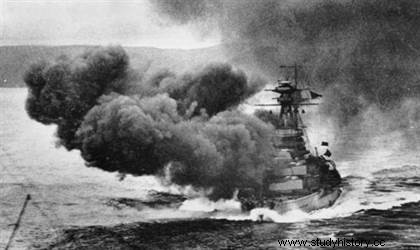
Fighting in the middle of the night
When night fell off Jutland, German hopes remained:Scheer was in his element against a Jellicoe who preferred to remain cautious. The fighting resumed, sporadic and just as confused as during the day. Scheer tries to avoid the encirclement, Jellicoe follows him trying to hit him without taking too many risks.
These are the light cruisers that resume combat after 10 p.m.:the Southampton manages to sink the Frauenlob . It is then the English destroyers who light up the night with their shots by launching new attacks. The cruiser Black Prince is less successful:he has lost contact with the Grand Fleet and plays misfortune by coming face to face with 1 ère German battleship squadron! Shortly after midnight, it exploded under fire from Thüringen , from Nassau and Friedrich der Grosse …The British destroyer attacks did not cease, however, and they were finally rewarded when a torpedo sent the battleship Pommern sinking.; it's 2:10 a.m. Meanwhile, the Lützow was abandoned and scuttled.
Results of the Battle of Jutland
The Battle of Jutland is over:the Hochseeflotte has managed to return to its waters, and Jellicoe knows there is no point in insisting. The record is impressive:in the waters of Jutland, the British lost the battlecruisers Queen Mary for good. , Indefatigable and Invincible , battlecruisers Defence , Warrior and Black Prince and eight destroyers for more than 6,000 dead (for 60,000 engaged). The Germans mourn the loss of the battlecruiser Lützow, from 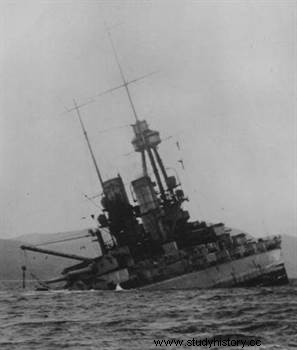 battleship Pommern , light cruisers Wiesbaden , Elbing , Rostock and Frauenlob as well as five destroyers, for more than 2,000 dead (out of 45,000 committed).
battleship Pommern , light cruisers Wiesbaden , Elbing , Rostock and Frauenlob as well as five destroyers, for more than 2,000 dead (out of 45,000 committed).
The Battle of Jutland saw nearly 250 ships, more than 100,000 men, who fired more than 20,000 shells! In points, it is obviously the Hochseeflotte which wins, in particular thanks to its superiority of artillery. England showed its superiority in terms of intelligence, but little more. However, the strategic victory is surely to the advantage of the British:the Grand Fleet retains its ability to defend the coasts and the lines of communication, while imposing a blockade on the Germans; the latter, on the other hand, will no longer dare to take their fleet out of the whole war.
The tragic fate of the Hochseeflotte
The powerful German fleet suffered an even more tragic fate in 1919:burned by Jutland, the British forced their enemy to deliver the Hochseeflotte to them in their own harbor in Scotland, Scapa Flow, supreme humiliation! Refusing to have his fleet shared between the victors, Vice-Admiral Ludwig von Reuter ordered the ships to be scuttled on June 21, 1919. The British, surprised, could not prevent more than fifty ships from escaping! Among them, several heroes of the Battle of Jutland, including Friedrich der Grosse , the König , the Seydlitz , the Derfflinger or the Von der Tann …
Non-exhaustive bibliography
- F.E. Brézet:Jutland, 1916:the greatest battle of all time. Editions Economica, 1992.
- F. Léomy, The Battle of Jutland, 1916, Socomer editions, 1992.
